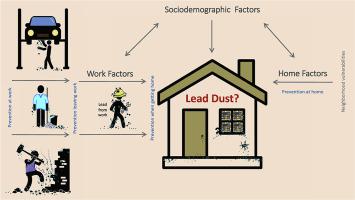Environmental Research ( IF 7.7 ) Pub Date : 2020-11-24 , DOI: 10.1016/j.envres.2020.110510 Diana M Ceballos 1 , Robert F Herrick 1 , Zhao Dong 1 , Andrew Kalweit 1 , Melisa Miller 2 , Jenna Quinn 2 , John D Spengler 1

|
Lead is a known reproductive, developmental, and neurological toxicant. Workers with a high likelihood of being exposed to lead at work may inadvertently transport lead home from work, known as “take-home exposure.” This is concerning for many workers for whom a workplace intervention is not feasible because their worksites and employers often change, rendering centralized strategies insufficient. This study aimed to better understand the connection between lead in the home of workers living with children and work in construction (n = 23), while other occupations were used as a comparison group (janitorial n = 5, autobody n = 2). Thirty workers living in disadvantaged communities in the Greater Boston area were recruited in 2018–2019 through collaboration with non-profits and worker unions with expertise working with low-income or immigrant workers. Construction workers that performed renovations, bridge constructions, welding, metal work, and demolitions were prioritized during recruitment. During a visit to their residences, a worker questionnaire was administered, and observations and a dust vacuumed sample of the home were collected. Factors predicting lead in home dust were explored by a bivariate analysis and a multivariable regression model. We found lead in homes’ dust in the range of 20–8,310 ppm. Homes of construction workers generally had higher and more variable lead dust concentrations (mean 775, max 8,300 ppm) than autobody and janitor worker homes combined (mean 296, max 579 ppm). Five of the construction workers’ home lead dust concentrations exceeded US guidelines for yard soil in children's play areas of 400 ppm, and were similar to other studies of homes near lead smelters, superfund sites, or in the Boston area in the early 1990s, pointing to disparities relating to work. Results from the multivariable regression model suggest that lead dust in homes of workers was associated with sociodemographic-, home-, and work-related factors, and pointed to overlapping vulnerabilities; however, a larger sample size is needed to verify findings. Results provide evidence that work-related factors are important to consider when assessing home exposures, and that take-home exposures for workers in lead high-risk jobs such as construction may be an important source of exposure in the home prime for public health intervention at work, home, and community levels.
中文翻译:

影响大波士顿地区建筑工人家中铅尘的因素
铅是一种已知的生殖、发育和神经毒物。在工作中极有可能接触铅的工人可能会不经意地将铅带回家,这被称为“带回家接触”。这对许多工作场所干预不可行的工人来说是令人担忧的,因为他们的工作地点和雇主经常变化,使得集中策略不足。本研究旨在更好地了解带孩子的工人家中铅含量与建筑工作(n = 23)之间的联系,同时将其他职业用作比较组(门卫 n = 5,汽车 n = 2)。2018-2019 年,通过与非营利组织和工会合作,招募了 30 名生活在大波士顿地区弱势社区的工人,这些工会具有与低收入或移民工人打交道的专业知识。在招聘过程中,优先考虑进行翻新、桥梁建设、焊接、金属加工和拆除的建筑工人。在访问他们的住所期间,对工人进行了问卷调查,并收集了观察结果和房屋的吸尘样本。通过双变量分析和多变量回归模型探索了预测家庭灰尘中铅含量的因素。我们发现家庭灰尘中的铅含量在 20–8,310 ppm 之间。建筑工人家中的铅尘浓度通常更高且变化更大(平均 775,最大值 8,300 ppm)比车身和看门人的家庭加起来还要多(平均 296,最大 579 ppm)。五名建筑工人的家庭铅尘浓度超过了美国对儿童游乐区院子土壤的指导方针 400 ppm,并且与 1990 年代初期铅冶炼厂、超级基金所在地或波士顿地区附近的其他家庭的研究相似,指出与工作有关的差异。多变量回归模型的结果表明,工人家中的铅尘与社会人口、家庭和工作相关因素相关,并指出重叠的脆弱性;然而,需要更大的样本量来验证结果。结果提供的证据表明,在评估家庭暴露时,与工作相关的因素很重要,











































 京公网安备 11010802027423号
京公网安备 11010802027423号